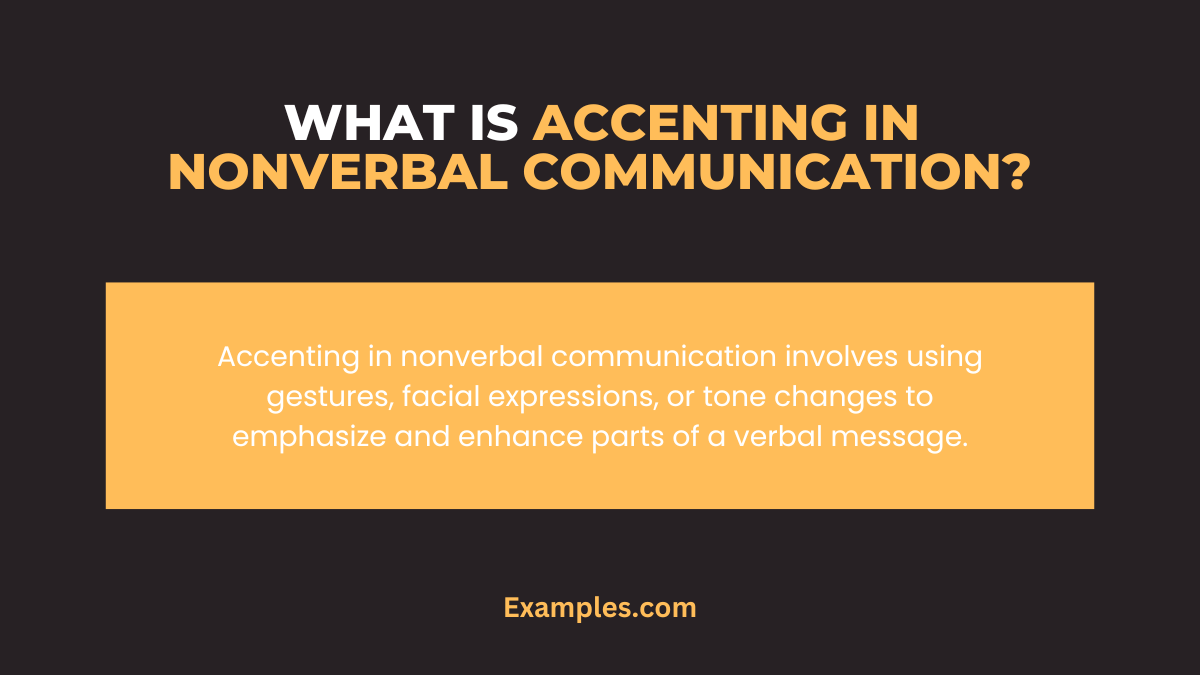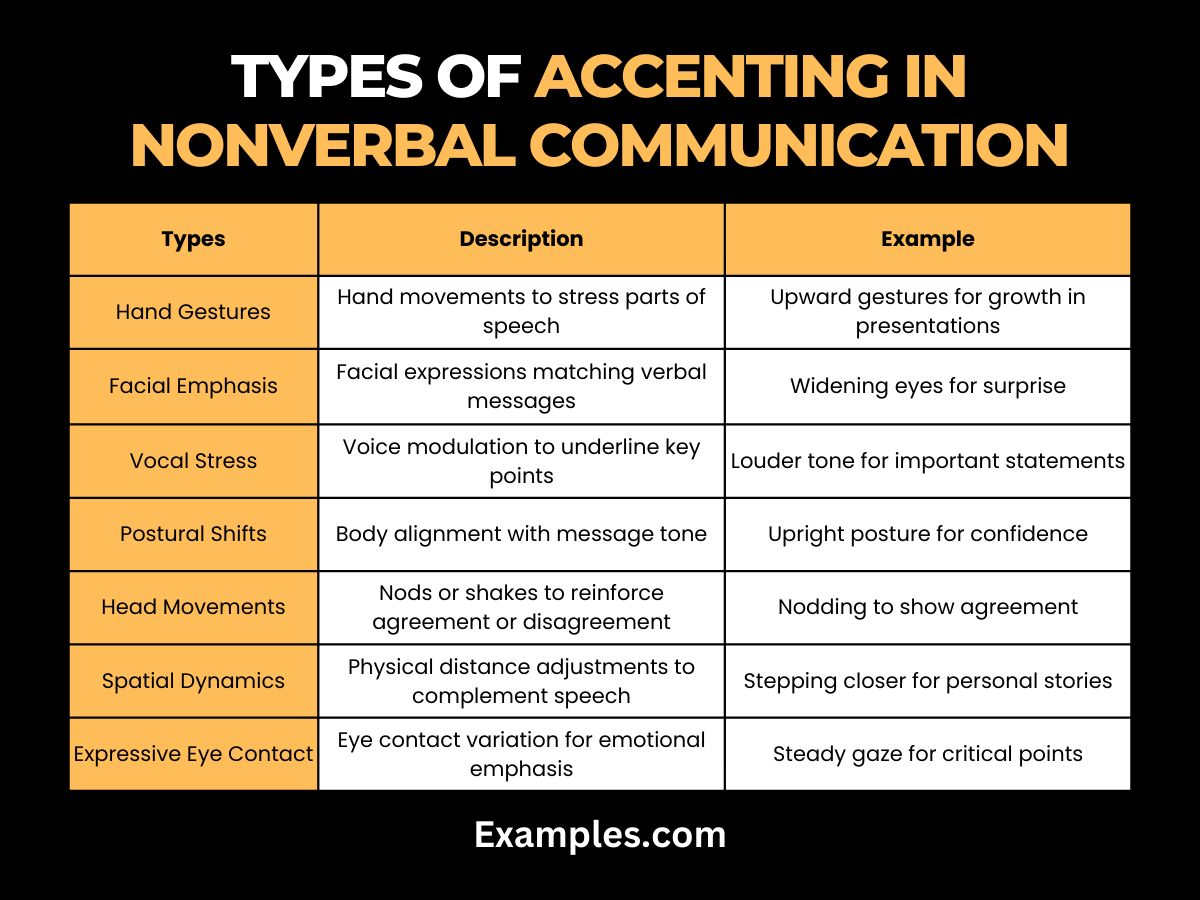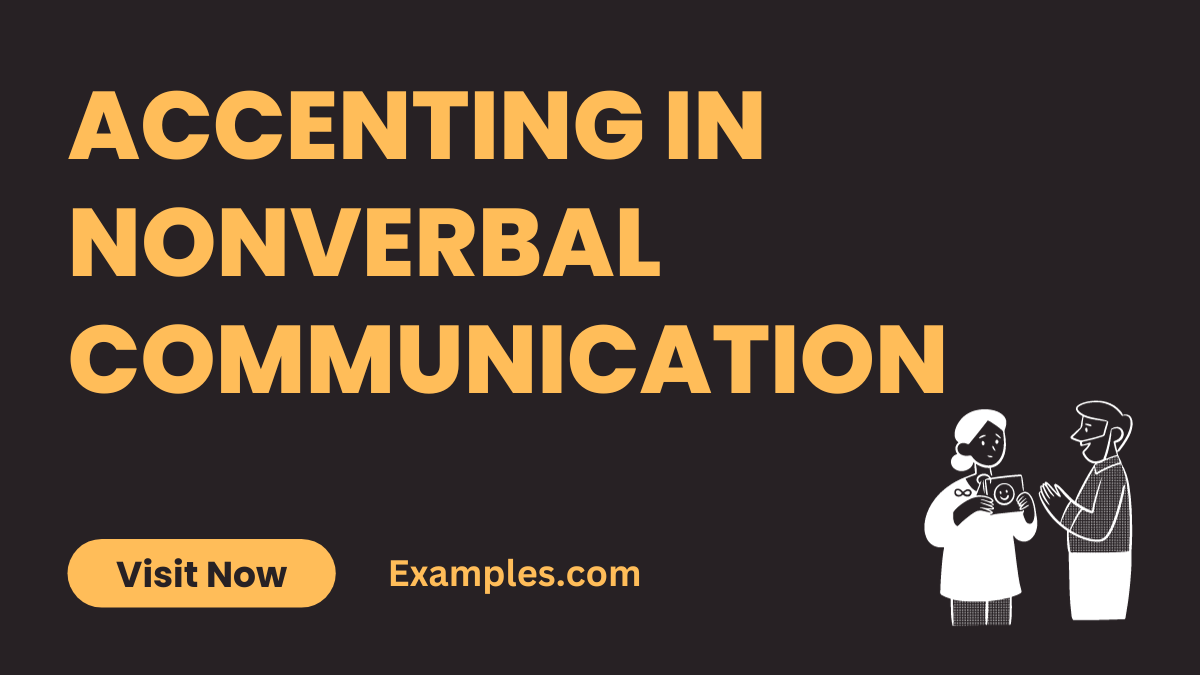9+ Accenting in Nonverbal Communication Examples
Accenting in nonverbal communication is a pivotal aspect that intensifies the impact of verbal messages. This facet involves using gestures, facial expressions, and tone variations to emphasize key points in spoken communication. By understanding and effectively employing accenting techniques, one can enhance the expressiveness and persuasiveness of their message. This guide explores the nuances of accenting, highlighting its role in adding emphasis and clarity to interactions in various settings, from daily conversations to formal presentations.
What is Accenting in Nonverbal Communication?

Accenting in nonverbal communication refers to the use of nonverbal cues to emphasize or underscore specific parts of a verbal message. This form of communication plays a crucial role in enhancing the meaning and impact of spoken words. It involves a variety of actions, such as gesturing, facial expressions, or changes in tone, which are used to highlight or draw attention to certain aspects of the verbal communication. For example, pounding a fist on a table to underline a point or using animated facial expressions to demonstrate enthusiasm. This technique is particularly effective in stressing the importance of a message, making it clearer and more memorable for the listener. Understanding and utilizing accenting in nonverbal communication can greatly enhance the effectiveness of interpersonal interactions, especially in contexts where conveying precise meaning is essential.
Types of Accenting in Nonverbal Communication

Accenting in nonverbal communication encompasses diverse methods to underscore verbal messages. Here’s a structured table outlining different types:
| Type | Description | Example |
|---|---|---|
| Hand Gestures | Utilizing hand movements to emphasize specific aspects of spoken words. | Gesturing upwards to signify growth or improvement in a presentation. |
| Facial Emphasis | Employing facial expressions to reinforce or highlight verbal statements. | Widening eyes to stress a surprising fact during a conversation. |
| Vocal Stress | Altering voice tone, pitch, or volume to underline spoken words. | Increasing volume slightly to highlight a key point in a discussion. |
| Postural Shifts | Changing body posture to align with the verbal message’s tone. | Straightening posture to demonstrate confidence when making an assertion. |
| Head Movements | Using nods or shakes of the head to accentuate verbal points. | Nodding vigorously to emphasize agreement with a statement. |
| Spatial Dynamics (Proxemics) | Adjusting the physical space between communicators to complement spoken words. | Stepping closer to the audience for emphasizing a personal anecdote. |
| Expressive Eye Contact | Intensifying or softening eye contact to align with the message’s emotional tone. | Holding steady eye contact when conveying a critical point. |
| Pacing and Pausing | Utilizing speech speed and pauses for emphasis. | Slowing down speech when delivering an important concept. |
These various forms of accenting in nonverbal communication play a pivotal role in enhancing the effectiveness and clarity of verbal interactions, allowing for more
What are the Ways of Accenting in Nonverbal Communication
- Strategic Gestures: Using deliberate hand movements to draw attention to certain points.
- Expressive Facial Expressions: Conveying emotions that align with the verbal message to reinforce its impact.
- Tone Variation: Adjusting speech tone to emphasize certain words or phrases.
- Intentional Posturing: Adopting postures that reflect the tone of the conversation, such as leaning forward to show engagement.
- Focused Eye Contact: Maintaining eye contact during crucial parts of the conversation.
What is the Importance of Accenting in Nonverbal Communication?
Accenting in nonverbal communication plays a vital role in enhancing the effectiveness of verbal interactions. This aspect of communication is significant for several reasons:
Enhancing Clarity and Emphasis
- Clarifies Verbal Messages: Accenting through nonverbal cues like gestures or tone variations helps clarify the meaning of verbal messages, ensuring that the communication is understood as intended.
- Adds Emphasis: By accenting key points with nonverbal signals, speakers can emphasize the parts of their message they consider most important, making it more impactful and memorable.
Aiding in Emotional Expression and Engagement
- Conveys Emotions: Nonverbal cues in accenting, such as facial expressions, can effectively convey emotions that words alone might not fully express, adding depth to the communication.
- Engages the Audience: Effective use of accenting captures the attention of the audience, making the interaction more engaging and dynamic.
Facilitating Persuasive Communication
- Increases Persuasiveness: Accenting important points nonverbally can make arguments more persuasive, especially in contexts like public speaking, teaching, or sales.
- Reinforces Arguments: Through strategic nonverbal cues, speakers can reinforce their verbal arguments, making them more compelling and easier to follow.
Building Authenticity and Trust
- Indicates Sincerity: Consistent use of accenting can indicate the speaker’s sincerity and conviction, building trust in interpersonal communications.
- Reflects Confidence: When speakers use nonverbal cues to accent their messages confidently, it reflects their self-assurance and command over the subject.
Tips for Accenting in Nonverbal Communication
Effectively using accenting in nonverbal communication can significantly enhance the impact of your verbal messages. Here are some tips to master this skill:
Be Aware of Your Gestures
- Use Appropriate Gestures: Align your hand and body gestures with the tone and content of your verbal message for added emphasis.
- Avoid Overuse: Be mindful not to overuse gestures, as this can distract from the verbal message rather than complement it.
Practice Facial Expressions
- Express Emotions Clearly: Use facial expressions that accurately reflect the emotions or sentiments you are expressing verbally.
- Consistency is Key: Ensure your facial expressions are consistent with the message you are communicating to avoid sending mixed signals.
Modulate Your Tone of Voice
- Vary Pitch and Volume: Adjust the pitch and volume of your voice to emphasize key points in your speech or conversation.
- Reflect Emotions in Tone: Let your tone of voice convey the emotions or urgency of your verbal messages.
Utilize Eye Contact Effectively
- Maintain Appropriate Eye Contact: Use eye contact to engage with your audience and underscore important messages.
- Balance is Important: While maintaining eye contact is crucial, it’s important to balance it to avoid making the listener uncomfortable.
Be Conscious of Your Posture
- Adopt an Open Posture: An open and relaxed posture can make you appear more approachable and receptive during communication.
- Use Posture to Emphasize Points: Leaning in slightly can demonstrate interest or emphasize the importance of what is being said.
Understand the Context
- Cultural Sensitivity: Be aware of cultural differences in nonverbal cues and adapt your accenting methods accordingly.
- Adapt to the Situation: The use of nonverbal accenting should be adapted to suit the formality and context of the situation.
Practice and Observe
- Self-Reflection: Regularly reflect on and practice your nonverbal communication skills.
- Learn from Others: Observe how skilled communicators use nonverbal accenting and try to incorporate similar techniques.
As we conclude our exploration of accenting in nonverbal communication, it’s evident that the power of these unspoken cues lies in their ability to enrich and clarify our spoken words. The subtlety and effectiveness of accenting, whether through gestures, facial expressions, or tone, play a crucial role in enhancing understanding and engagement in any form of communication. Mastering this aspect of nonverbal communication can lead to more impactful and persuasive interactions, making it a valuable skill in both personal and professional domains.
For further reading and resources on developing effective communication skills, the Stanford University School of Education offers insightful articles and courses that delve deeper into the nuances of interpersonal and professional communication. Additionally, for those interested in a psychological perspective on nonverbal cues, the American Psychological Association provides a wealth of research and resources, offering a deeper understanding of the underlying dynamics of nonverbal communication.



